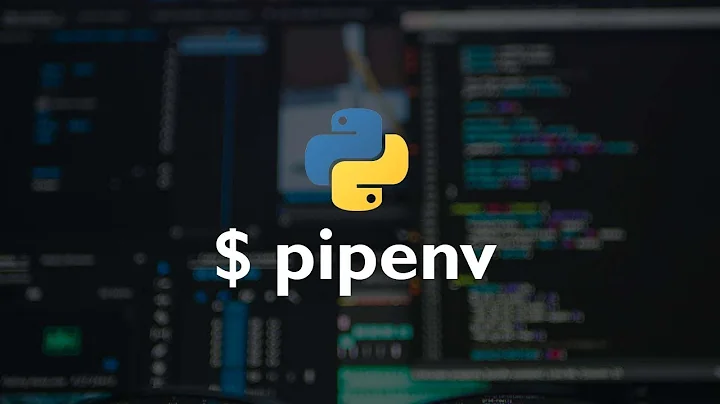Pipenv: Command Not Found
Solution 1
That happens because you are not installing it globally (system wide). For it to be available in your path you need to install it using sudo, like this:
$ sudo pip install pipenv
Solution 2
This fixed it for me:
sudo -H pip install -U pipenv
Solution 3
If you've done a user installation, you'll need to add the right folder to your PATH variable.
PYTHON_BIN_PATH="$(python3 -m site --user-base)/bin"
PATH="$PATH:$PYTHON_BIN_PATH"
See pipenv's installation instructions
Solution 4
I tried this:
python -m pipenv # for python2
python3 -m pipenv # for python3
Solution 5
I have same problem with pipenv on Mac OS X 10.13 High Seirra, another Mac works just fine. I use Heroku to deploy my Django servers, some in 2.7 and some in 3.6. So, I need both 2.7 and 3.6. When HomeBrew install Python, it keeps python points to original 2.7, and python3 points to 3.6.
The problem might due to $ pip install pipenv. I checked /usr/local/bin and pipenv isn't there. So, I tried a full uninstall:
$ pip uninstall pipenv
Cannot uninstall requirement pipenv, not installed
You are using pip version 9.0.1, however version 10.0.1 is available.
You should consider upgrading via the 'pip install --upgrade pip' command.
$ pip3 uninstall pipenv
Skipping pipenv as it is not installed.
Then reinstall and works now:
$ pip3 install pipenv
Collecting pipenv
Related videos on Youtube
lgants
Updated on April 23, 2022Comments
-
lgants about 2 years
I'm new to Python development and attempting to use pipenv. I ran the command
pip install pipenv, which ran successfully:... Successfully built pipenv pathlib shutilwhich pythonz-bd virtualenv-clone Installing collected packages: virtualenv, pathlib, shutilwhich, backports.shutil-get-terminal-size, pythonz-bd, virtualenv-clone, pew, first, six, click, pip-tools, certifi, chardet, idna, urllib3, requests, pipenv ...However, when I run the command
pipenv installin a fresh root project directory I receive the following message:-bash: pipenv: command not found. I suspect that I might need to modify my .bashrc, but I'm unclear about what to add to the file or if modification is even necessary.-
phd over 6 yearsCheck
/usr/local/bin/pipenv— is it there? Is/usr/local/binin your$PATH? -
aDone over 6 yearsSame problem here: succesfully built pipenv but no sign of pipenv folder in /usr/local/bin .
-
dethos over 6 yearsAre you installing
pipenvglobally? -
kojiro about 3 yearsThis is a popular question with a lot of highly upvoted answers that recommend the use of
sudo; however,sudois a dangerous command that should not be run without careful consideration. Please do not blindly copy and paste from the answers here. -
Brijesh about 2 yearsFor Windows, 1. In Gitbash do this and check the location packages. pip list -v and this will give the list of packages and the location the are installed. 2. In command Prompt (cmd) enter PATH and check in output if the c:\users\test\appdata\roaming\python\python36\Scripts or the path mentioned in output of 1st command is there, if not present update the system Env variable. 3. Close the CMD prompt and GIt Bash and check again, PIPENV should work now.
-
-
michael over 6 yearsfor the copy-and-pasters out there, this command is usually run as
sudo -H pip install -U pipenv(eg on ubuntu), installingpipenvin/usr/local/bin. The alternative is a user install, e.g.,$ pip install pipenv, which is the same as$ pip install --user pipenv, which installs things in$HOME/.local/..., requiring thePATHto be modified as in the other answer, stackoverflow.com/a/47111756/127971 -
 eksortso over 6 yearsThis was useful, in that I needed to run
eksortso over 6 yearsThis was useful, in that I needed to runpipenv run, and the installation instructions told me so. -
 Andrey Vaganov about 6 years@Babbz77 The -H (HOME) for sudo option requests that the security policy set the HOME environment variable to the home directory of the target user (root by default) as specified by the password database. The -U for pip install upgrade all specified packages to the newest available version. The handling of dependencies depends on the upgrade - strategy used.
Andrey Vaganov about 6 years@Babbz77 The -H (HOME) for sudo option requests that the security policy set the HOME environment variable to the home directory of the target user (root by default) as specified by the password database. The -U for pip install upgrade all specified packages to the newest available version. The handling of dependencies depends on the upgrade - strategy used. -
 Claudio Santos about 6 yearsYou must test
Claudio Santos about 6 yearsYou must testpython3 -m siteto see if the --user-base dir exist! -
 Ozkan Serttas about 4 yearsI installed python3 through Homebrew. When ran
Ozkan Serttas about 4 yearsI installed python3 through Homebrew. When ranwhich python3the output was/Cellar/python/3.7.7/bin/python3which I assigned it to my PATH but still ``pipenv` not found`. Any idea? -
kojiro about 3 yearsSudo is dangerous and just not needed for this. Folks should really never run
sudo pip installanywhere. Most likely you'd want to use your package manager, be it apt, or homebrew, or whatever. For example,brew install pipenvworks nicely on macOS. If your package manager doesn't happen to have pipenv in its catalog, thenpip install --useris a reasonable alternative. -
 FedericoCapaldo over 2 yearsthis made it work, many thanks!
FedericoCapaldo over 2 yearsthis made it work, many thanks! -
analyst_47 over 2 yearsThank you for this
-
 Jason R Stevens CFA over 2 yearsThis is the right way to rock the local installation. Thank you!
Jason R Stevens CFA over 2 yearsThis is the right way to rock the local installation. Thank you! -
 thenewjames about 2 years
thenewjames about 2 yearsbrew install pipenvis discouraged by the maintainers -
Can about 2 yearsThanks! This solved it for me on windows!
![[SOLVED] pip is not recognized as an internal or external command, operable program or batch file](https://i.ytimg.com/vi/An2UBGAlzpU/hq720.jpg?sqp=-oaymwEXCNAFEJQDSFryq4qpAwkIARUAAIhCGAE=&rs=AOn4CLD9Ve77U1s9wP0LqpLoZwOrZ5VTRg)




